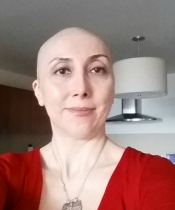

Good friends have said, “But you must have seen it coming.”1 The truth is that I saw it coming for years but I did not have the knowledge to recognize it.
I was diagnosed with ovarian cancer Stage 1C in November 2014 at the age of 45. Before my diagnosis, I had a normal life and was very active. I used to work in the oil and gas business so I traveled a lot, managed all sorts of crises, and had a wonderful partner.
However, for years, I was suffering from persistent bloating, difficulty in eating, painful intercourse and lower back pain. All the physicians I saw blamed these symptoms on my stomach or my state of mind.
In the last month prior to my diagnosis, I was suffering from urinary symptoms as well. I went to hospital thinking that I had an urinary tract infection but an observant doctor there told me that it is unusual to have such symptoms for a long time. She did a pelvic exam, found a cyst, ordered an endovaginal (transvaginal) ultrasound, found a mass in my left ovary, and referred me to a gynecologist. The gynecologist referred me to a gynecologic oncologist. Four days later, I had surgery including a compete hysterectomy (which sent me directly into menopause).
My treatment was carboplatin for six months. Despite the side effects of chemotherapy, and despite the fact that my partner left me because he found the whole thing overwhelming, I felt good. I was heart-broken, but physically getting my strength back. My CA125 dropped to 7 in the three months after my last chemo treatment.
About that same time, I started to feel pain under my rib-cage and shortness of breath. A CT scan showed that I had two masses in my liver; a laparoscopy showed that I also had numerous tiny masses in my abdomen. The masses in my liver could not be removed because they were very close to my diaphragm and surgeons did not want to risk damaging my diaphragm.
I went back on chemotherapy; this time it was Avastin (bevacizumab) and Gemzar (gemcitabine). But it did not work — the masses got bigger in size , my CA125 increased, and the Avastin gave me horrible rashes on my face and body.
I volunteered for a NCI-MATCH Trial (Molecular Analysis for Therapy Choice)2 also known as MATCH. In this trial, patients are assigned to receive treatment based on the genetic changes in their tumors found through genomic sequencing and other tests.
Some samples was taken from the tumor in my abdomen and a genetic change was found. MATCH medication produced good results. However, after a while I got a bacterial infection which lasted for two months, and cancerous cells attacked my throat lymph. On the top of that, the needle that took samples deep from my abdomen seeded cancerous cells on the outer layer of my stomach and a tumor grew there as well!
Subsequently, I was removed from the trial and went back to traditional chemo with paclitaxel (Taxol) and Avastin.
As of last month (July 2017), I have finished three months of weekly chemotherapy and am waiting for the results of my last scan to show the way forward.
Despite all these ordeals, and despite an uncertain future, I never lost hope. I still believe that I can beat cancer and use the experience to help others. I have met inspiring women through the Ovarian Cancer Alliance who have taught me to never let pain define you but instead let it refine you.
I am receiving valuable information and support from the Ovarian Cancer Alliance which helps me to go through such hard times.
In conclusion, I would like to share a piece by Zoe Skyla. For those who have gone through illness, treatment and pain, it is relatable.For a star to be born,
there is one thing that must happen:
A gaseous nebula must collapse.
So collapse.
Crumble
This is not your destruction.
This is your birth.
1 Eric, Doris Lund, J.B. Lippincott Company, 1974, p.1
2https://www.cancer.gov/about-cancer/treatment/clinical-trials/nci-supported/nci-match/
